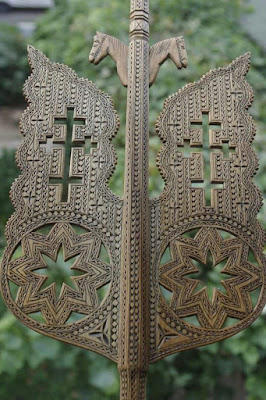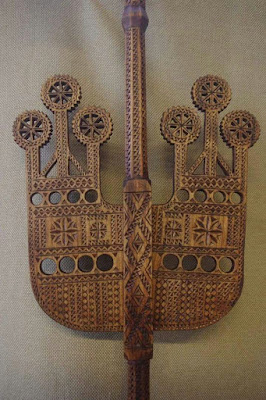I love finding utilitarian objects which have been made beautiful by someone spending more time than was necessary to add ornamentation to them. In the
Bauhaus movement, there arose a debate which ushered in a new way of seeing the making of objects, and was summed up with the phrase, "form follows function". This was a way of saying that a tool or object should first and foremost have a shape to it which suits its purpose. I have no problem with that notion, but I have no idea why that thought became licence for everything to be made without any beauty or art left to it. It is my opinion that the best approach to the question of design should be phrased as, "function has form", which is to say that even if it is functional, as it should be, it should also be pleasing to look at, and ornamented as nicely as possible, without sacrificing its usefulness.
To that end, I was delighted last week to see some objects that a long-time Romanian girlfriend of mine sent me from he home country. This type of object is called a "distaff" and they are made by her father-in-law. I was unaware of it, but apparently there is a long tradition all over Europe, Scandinavia, the Balkans and Russia of various forms of this type of artwork.
 |
| A "chip carved"spinning distaff made in Romania |
A Distaff is an object used to hold the linen (or other) fibers whilst the spinner converts them into threads. It is a very utilitarian object, and came be made as plain and crude as someone wishes, and it will still do its job. I found a photo on Flicker, of two women using a very simple version in some reenactment event. I have no idea who or where they are, so I censored their identity; the purpose of the picture is to show how the object is used.
 |
Two anonymous women demonstrating the traditional
method of spinning with a distaff |
Quite obviously, this tool does not need any decorations to be useful, but look at the following photos and see how much more pleasant such an object becomes when someone is willing to put into it more than the absolute minimum amount of effort necessary for its creation. When an Artist applies a bit of his soul to an object, that object takes on a soul of its own and becomes more than just a tool.
I have seen many beautiful things made in Romania since I first met the friend who sent these pictures in 1999 where she was demonstrating traditional Romanian egg-dying (another very intricate and beautiful art) at the annual Smithsonian Folk-life Festival in Washington DC. I also met a couple woodcarvers at the same time, and was impressed with the carved gate they were making at the time.
It is enjoyable for me to see people who work to keep traditional crafts, such as this, alive, and in so doing, make our modern sterile world a little less boring.
 |
All of these objects have been decorated with what
is known as "chip carving" but this one has the
addition of having a pair of horses carved, a nice
little touch of creative originality. |










No comments:
Post a Comment